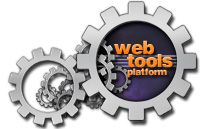|
JSF Tools Project Features for WTP Release 1.5 - JSF Tools
0.5 release
|
|
| |
 | Updated: 06/16/2006 |
|
|
This document defines the set of features that will be
delivered in the WTP1.5-JSF Tools 0.5 release. This is an
update on the
draft document
to reflect the current status.
|
|
|
The features delivered in this release are aimed at
improving the development experience of a user in building
and deploying a JavaServer Faces application.
|
| Features |
|
| |
|
|
I. JSF-JSP Page Source Editor Features.
|
|
|
1. Content Assist for values of tag attributes for the JSF
standard Core and HTML tag libraries
The JSF-JSP editor provides content completion for specific
attribute values of the JSF standard Core and HTML tags.
Content Assist is available for both Expression Language
(EL) and non-EL values.Support includes providing a proposal
for values of attributes that have discrete set of values,
references to application configuration type including
managed bean and resource bundle.
|
|
|
2. JSF Page validation
The Editor now supports semantic validation for both EL and
non-EL values of attributes of the JSF standard Core and
HTML tags. EL validation includes basic syntax checks,
exisitence of managed beans, resource bundle and their
properties, correct type and method signatures.
|
|
|
3. Extensible Framework
This release includes a collection of core frameworks that
will enable JSF component developers, tool providers to
enhance and extend the above mentioned features. These
include:
-
Content Model Annotation Framework
Define additional meta-data for elements and
attributes on any xml-based content model for
use at design time.
-
Design-time Meta-data Processing Framework
-
Uses the annotations framework to provide
services to the JSF-JSP Source Editor
-
Define new services and enhance existing
services
-
Design-time Application Manager
-
Provide an approximation of certain JSF
runtime state information at design time.
-
Pluggable design-time variable, property and
method resolvers
-
JSF Application Configuration Manager
-
Provide a unified application configuration
model through API, effectively merging all
faces configuration models into a single
model
-
Notification services to monitor changes to
the EMF objects in the model
-
Cross model validation will be supportable .
|
|
|
II. Application Configuration Editor Features.
The JSF configuration editor is a multi-page editor. It
provides both a graphical view and a text view of the
faces-config.xml file. An EMF model of the application
configuration resolrce file has been provided. The editor
has the following main features:
-
A summary page – a form based editor, summaries all
elements configured in the faces-config.xml file.
-
A graphical representation of navigation rules – a
graphical view shows how the pages and actions are
linked together in the navigation rule element. The
editor support drag-n-drop of exisiting pages. It
also has a tool palette.
-
Managedbean page – a form based editor, has a tree
view display of all managedbeans configured in the
project. It provides wizard dialogs to guide user to
create and configure new managedbeans.
-
Component page – a form based editor, displays
commonly used elements in the project. Elements are
grouped in a section and have a list view of all
elements in each group. It also provides dialogs to
create or modify those elements.
-
Others page – a form based editor, display all other
advanced elements in the project. Those elements are
grouped in a section and have a list view of all
elements in each group. It also provides dialogs to
create or modify those elements.
-
Text editor page – a source page editor, provides
content assist and syntax highlighting when user
edits the faces-config file.
|
|
|
III. Management Features.
1. Register JSF Libraries.
This allows a user to define a named collection of JARs and
optionally tag a collection as a JSF implementation. A user
can thus define and manage distinct groups of JSF
implementations, components and utility Java libraries.The
user experience will be similar to that of registering the
JRE. For each named collection defined, a user can specify:
- Name
- JSF Version supported
- Collections of JARs/ZIPs of Java Libraries
- Implementation Flag
- Default Implementation Library
|
|
|
2. Create a Dynamic Web Project with the JSF Project
Facet.
|
|
|
3. Add the JSF Project Facet to an existing Dynamic Web
Project.
|
|
|
In both the scenarios, a user has the following options to
choose:
-
Select JSF implementation from registry. Users have
the option to deploy the JARs in the library to the
"WEB-INF\lib" folder. Users can also register new
implementation libraries during facet installation.
- Select the JSF Version
-
Create single application configuration resource
file
-
Filename defaults to "faces-config.xml", and
Location defaults to ".../WEB-INF". Both can be
modified.
-
Update context-param in web.xml if selected
location/filename is not
"WEB-INF/faces-config.xml"
-
Update the web.xml with JavaServer Faces servlet and
servlet-mapping information
|
|
|
4. Run/ Debug a JSF JSP Page on the Server.
Only JSF pages with the .jsp file extension are
currently supported.
|

